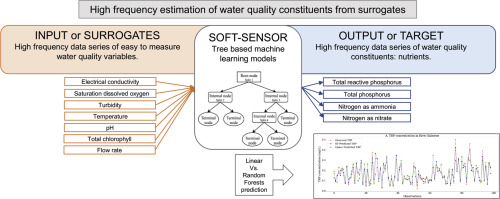Water Research ( IF 12.8 ) Pub Date : 2020-01-11 , DOI: 10.1016/j.watres.2020.115490 María Castrillo , Álvaro López García

|
Continuous high frequency water quality monitoring is becoming a critical task to support water management. Despite the advancements in sensor technologies, certain variables cannot be easily and/or economically monitored in-situ and in real time. In these cases, surrogate measures can be used to make estimations by means of data-driven models. In this work, variables that are commonly measured in-situ are used as surrogates to estimate the concentrations of nutrients in a rural catchment and in an urban one, making use of machine learning models, specifically Random Forests. The results are compared with those of linear modelling using the same number of surrogates, obtaining a reduction in the Root Mean Squared Error (RMSE) of up to 60.1%. The profit from including up to seven surrogate sensors was computed, concluding that adding more than 4 and 5 sensors in each of the catchments respectively was not worthy in terms of error improvement.
中文翻译:

使用机器学习方法从水质替代物中估算高频营养物浓度
持续的高频水质监测已成为支持水管理的一项关键任务。尽管传感器技术取得了进步,但是某些变量仍无法轻松地和/或经济地就地和实时地进行监控。在这些情况下,可以使用替代措施通过数据驱动模型进行估算。在这项工作中,通常使用就地测量的变量作为替代指标,以利用机器学习模型(特别是随机森林)来估算农村流域和城市流域中养分的浓度。将结果与使用相同数量的代理进行线性建模的结果进行比较,可将均方根误差(RMSE)降低多达60.1%。计算了最多包含七个代理传感器的利润,


























 京公网安备 11010802027423号
京公网安备 11010802027423号